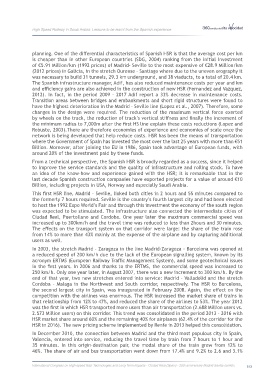Page 515 - 360.revista de Alta Velocidad - Nº 6
P. 515
High Speed Railway in Saudi Arabia: Lessons to be learnt from the Spanish experience
planning. One of the differential characteristics of Spanish HSR is that the average cost per km
is cheaper than in other European countries (SDG, 2004) ranking from the initial investment
of €5.91 Million/km (1992 prices) of Madrid- Seville to the most expensive of €28.9 Million/km
(2012 prices) in Galicia, in the stretch Ourense – Santiago where due to the uneven orography it
was necessary to build 31 tunnels, 29.3 km underground, and 38 viaducts, to a total of 20.4 km.
The Spanish infrastructure manager, Adif, has also reduced maintenance costs per year and km
and efficiency gains are also achieved in the construction of new HSR (Fernandez and Vazquez,
2012). In fact, in the period 2009 – 2017 Adif report a 33% decrease in maintenance costs.
Transition areas between bridges and embankments and short rigid structures were found to
have the highest deterioration in the Madrid – Seville line (Lopez et al., 2007). Therefore, some
changes in the design were required. The reduction of the maximum vertical force exerted
by wheels on the track, the reduction of track’s vertical stiffness and finally the increment of
the minimum radius to 7,000m after the first HS line explain these costs reductions (Lopez and
Robuste, 2003).There are therefore economies of experience and economies of scale once the
network is being developed that help reduce costs. HSR has been the means of transportation
where the Government of Spain has invested the most over the last 25 years with more than €51
Billion. Moreover, after joining the EU in 1986, Spain took advantage of European funds, with
around 20% of the investment paid by these funds.
From a technical perspective, the Spanish HSR is broadly regarded as a success, since it helped
to improve the service standards and the quality of infrastructure and rolling stock. To have
an idea of the know-how and experience gained with the HSR; it is remarkable that in the
last decade Spanish construction companies have exported projects for a value of around €10
Billion, including projects in USA, Norway and especially Saudi Arabia.
This first HSR line, Madrid – Seville, linked both cities in 2 hours and 55 minutes compared to
the formerly 7 hours required. Seville is the country’s fourth largest city and had been elected
to host the 1992 Expo World’s Fair and through this investment the economy of the south region
was expected to be stimulated. The infrastructure also connected the intermediate cities of
Ciudad Real, Puertollano and Cordoba. One year later the maximum commercial speed was
increased up to 300km/h and the travel time was reduced to less than 2hours and 30 minutes.
The effects on the transport system on that corridor were large: the share of the train rose
from 14% to more than 43% mainly at the expense of the airplane and by capturing additional
users as well.
In 2003, the stretch Madrid – Zaragoza in the line Madrid-Zaragoza - Barcelona was opened at
a reduced speed of 200 km/h due to the lack of the European signalling system, known by its
acronym ERTMS (European Railway Traffic Management System), and some geotechnical issues
in the first years. In 2006 and thanks to the ERTMS, the commercial speed was increased to
250 km/h. Only one year later, in August 2007, there was a new increment to 300 km/h. By the
end of that year, two new stretches entered into service: Madrid – Valladolid and the stretch
Cordoba – Malaga in the Northwest and South corridor, respectively. The HSR to Barcelona,
the second largest city in Spain, was inaugurated in February 2008. Again, the effect on the
competition with the airlines was enormous. The HSR increased the market share of trains in
that relationship from 12% to 47%, and reduced the share of the airlines to 53%. The year 2012
was the first in which HSR transported more users than air transportation (2.688 Million users vs.
2.573 Million users) on this corridor. This trend was consolidated in the period 2013 – 2016 with
HSR market share around 60% and the remaining 40% for airplanes (62.4% of the corridor for the
HSR in 2016). The new pricing scheme implemented by Renfe in 2013 helped this consolidation.
In December 2010, the connection between Madrid and the third most populous city in Spain,
Valencia, entered into service, reducing the travel time by train from 7 hours to 1 hour and
35 minutes. In this origin-destination pair, the modal share of the train grew from 12% to
46%. The share of air and bus transportation went down from 17.4% and 9.2% to 2.6 and 3.1%
International Congress on High-speed Rail: Technologies and Long Term Impacts - Ciudad Real (Spain) - 25th anniversary Madrid-Sevilla corridor 513

